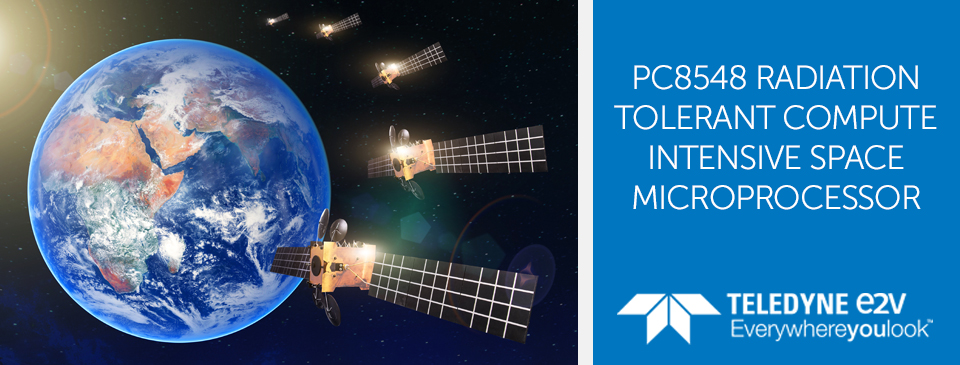
1. Introduction
Let us take you into a Space journey today, not far from the stars in the sky above us… or at least not far from the core of the systems in orbit on top of us!
In the galaxy of Space systems designers, who has never dreamt about a radiation tolerant system on chip solution, featuring advanced Giga-Hertz processing elements for heavy computing such as telecommunications, earth observation, or even AI, in a reduced footprint and in a reduced power envelope?
This solution is PC8548 part of Teledyne e2v Space Microprocessor portfolio, with the following key features:
Prior to go further into the details, let’s propose a high level overview allowing to better understand what we are describing.
2. PC8548 Radiation Tolerant Microprocessor positioning versus Radiation Hardened Microcontrollers.
When it comes to Space Microprocessors, one often mixes Micro-Processors versus Micro-Controllers, and radiation tolerant (RAD TOL) versus “radiation hardened by design” (RAD HARD) systems.
Space Microprocessors will be performing all heavy computing activities, and can tolerate radiation events, or faults at the same time, as long as those errors can be detected, quantified, and removed by sub system reset.
To perform tasks in Space such as monitoring, power supply management, watchdog,…, Micro-controllers are the best candidates, in conjunction with a radiation hardened capability, in order to make sure that the Space system (or the satellite) will never face any failure (such as latch up or Single Event Functional Interrupt) while in Space. Figure 1 highlights these main differences.
 Figure 1: Micro Processors & Controllers versus Radiation Tolerance
Figure 1: Micro Processors & Controllers versus Radiation Tolerance
3. PC8548 Space Microprocessor Features
PC8548 combines a Power Architecture® e500 core with on-chip peripherals such as SDRAM/DDR/DDR2 memory controllers and high-speed communication interfaces:
Reliability is paramount for products entering Space and PC8548 is following the QML Y certification. QML Y certification was defined by a NASA led working group, and officially published in the latest revision of DLA MIL-PRF-38535. The traditional QML V certification was only compatible with legacy hermetic assembly processes and new generation assembly techniques (such as flip-chip on ceramic) and subsequent manufacturing, screening and qualification flows were not taken into account.
QML Y allows Space systems manufacturers to benefit from the latest technologies whilst still ensuring that each device produced is carefully verified; PC8548 is a flip-chip non hermetic QML Y Space Microprocessor.
 Figure 2: NXP PC8548 Block Diagram
Figure 2: NXP PC8548 Block Diagram
4. PC8548 Space Microprocessor Performances
In terms of performances, one will have a look on Figure 2, highlighting that a PC8548 is 9 times more powerful than a LEON3 based Space System on Chip, and 35% more powerful that a more recent quad core LEON4 based Space SoC.
 Figure 3: Performance comparison
Figure 3: Performance comparison
5. Radiation performances:
Below are summarized the radiation performances of PC8548. Radiation Testing campaings have been made by Teledyne e2v, and radiation reports can be available to customers on request.
PC8548 is a flip-chip non hermetic QML Y Radiation Tolerant Space Microprocessor.
6. Flight Heritage, Space Qualification & Manufacturing Lead time
Teledyne e2v has successfully manufactured and delivered 250+ Flight Models so far.
Some of the manufactured Flight Models are used in famous Space programs such as, but not limited to, Communication satellites. PC8548 is mostly deployed in LEO applications so far, with 10-15 years lifetime in Space.
Teledyne e2v has been shipping PC8548 Flight Models in Europe, US & Asia.
Space designers and manufacturers know that Flight Model Manufacturing is a long process, involving Space Level Screening, Lot by Lot qualification, Quality Conformance Inspections.
However, due to the processor high level of success in the Space Community, Teledyne e2v has made it a Space Off The Shelf Space Microprocessor, with the capability to deliver Flight Models in less than 4 weeks, and from the same diffusion lot.
If you want to know more about the Teledyne e2v Space Qualification, order a free Teledyne e2v Space Qualification Flow Poster, A0 or A1 Format.